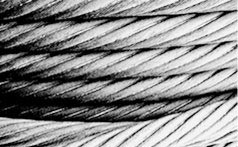As a result of the heavy responsibilities placed on wire rope, it is no wonder why a cable suffers from wear and tear. The most common problem that occurs when using wire rope, is block twisting or cabling. This is especially the case for companies using wire rope within the construction industry. When this happens, it is easy to blame the rope, but normally there are other issues that need to be addressed.
Each time a load is applied to a wire rope, it will slightly twist or unlay. With time, the wire rope will eventually suffer from block twisting or rope distortion. When the problem gets too big (roughly 180 degrees of twisting), it is best to no longer use the rope. Using a rope that has been cabled is dangerous and unsafe for workers.
If you notice that block twisting is happening frequently, you should take a few steps to reduce the problem. Block twisting can be lessened if:
- The length of the wire is reduced
- The weight of individual loads is lessened
- Odd-part reeving can be reduced or eliminated
- The dead end of the rope is relocated to the end of the boom
- The size of sheaves is increased
- A tag line is used to resist twisting
RELATED READING FOR WRIE ROPE: